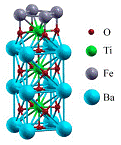Department of Physics and Astronomy: Publications and Other Research

Evgeny Tsymbal Publications
ORCID IDs
Tsymbal http://orcid.org/0000-0002-6728-5530
Document Type
Article
Date of this Version
1-25-2016
Citation
Physical Review B (2016) 93: 024419
Abstract
Tunneling anisotropic magnetoresistance (TAMR) is the difference in resistance of a magnetic tunnel junction due to a change in magnetization direction of one or both magnetic electrodes with respect to the flow of current. We present the results of first-principles density functional calculations of the TAMR effect in magnetic tunnel junctions with La0.7Sr0.3MnO3 (LSMO) electrodes and a SrTiO3 (STO) tunneling barrier. We find an ∼500% difference in resistance between magnetization in the plane and out of the plane. This large TAMR effect originates from the half-metallic nature of LSMO: When magnetization is out of plane spin-orbit coupling (SOC) contributions to the transmission come only from spin-flip scattering, which is intrinsically small due to the half-metallicity. For in-plane magnetization, however, there is a large non-spin-flip SOC contribution to the conductance. The large magnitude of the effect stems from the additional fact that there is an inherent polar discontinuity between LSMO and STO which leads to quasilocalized states at the interface whose influence on tunneling is strongly dependent on the magnetization orientation.


Comments
Copyright 2016, American Physical Society. Used by permission